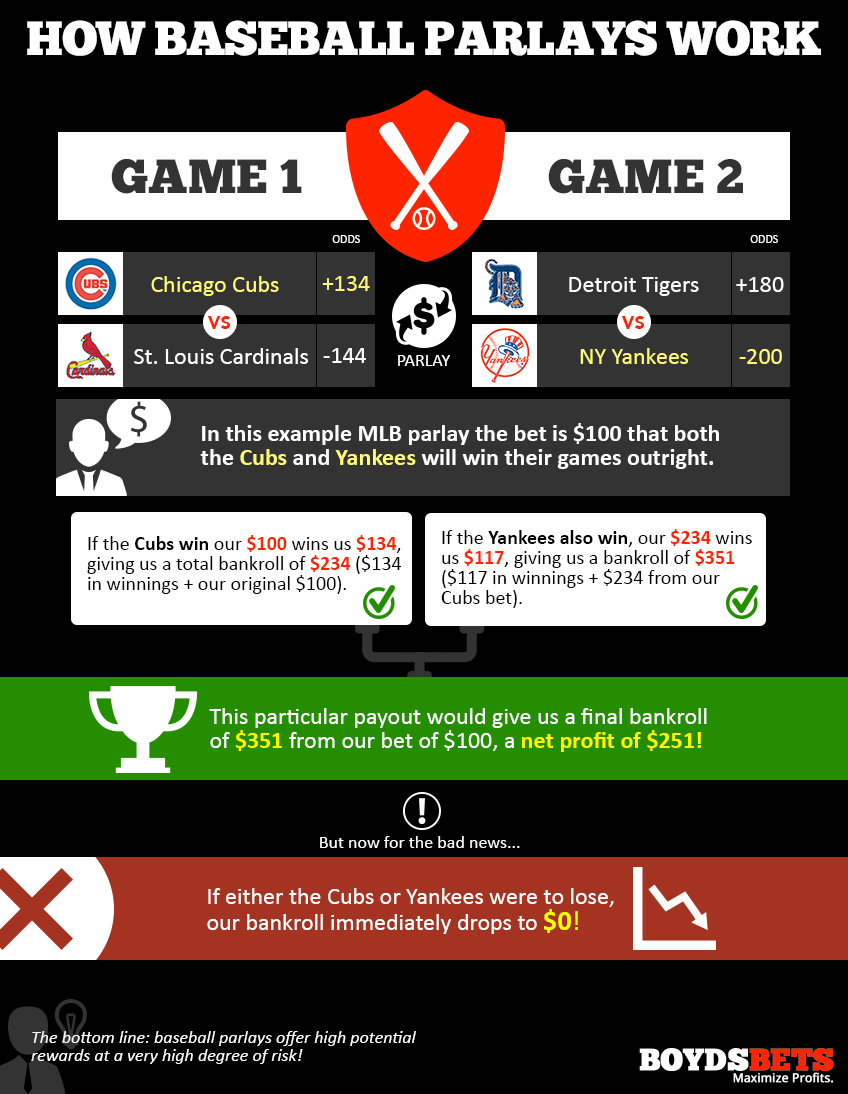Understanding How to Bet & Handicap Winning Parlay Picks in Baseball
How Parlays Work
Most of you reading this article are likely already familiar with how parlays work. But, I wanted to take a quick second and explain it for anyone who isn’t familiar with this type of wager.
A parlay is a single bet that combines two or more individual bets into one wager.
The payouts are much bigger than if you were to bet the plays separate of one another. The kicker is that in a parlay the individual bets all must win. If any one team loses, the entire wager is lost.
How to Calculate Your Payouts
The basic principle of a parlay is that you are doubling down the profits from each bet onto the next one. I’ve already mentioned that the payouts are better than betting each play individually. But, you might be asking yourself how to do you determine how much you will win.
Let’s say you wanted to place a $100 bet on a 3-teamer on the Yankees -150, Cubs +125, and the Dodgers -120.
Here’s how you calculate your payout. The first step is to pick one of the individual wagers. Calculate what you would win on a standard bet given the amount of your wager.
Then, take the amount you would receive back if that first play were to win. Calculate your payout if you placed those winnings on one of the two remaining wagers.
You continue to do this until you have included each individual wager.
Example:
Let’s say the first team you picked for calculating your payout was the Yankees -150. A $100 bet on the Yankees -150 would profit $66.67, giving you a total return of $166.97 (original bet + profit).
Next up is your Cubs +125 bet. A $166.67 bet on the Cubs +125 would profit $208.34. This increases your bankroll to $375.01 ($166.97 + $208.34).
The last team left to calculate is the Dodgers -120. A $375.01 bet on the Dodgers -120 would profit $312.51 and end up cashing out a ticket of $687.52.
Since you have no more individual bets left, the amount you profited on the third and final game is the amount you would profit on your bet.
It doesn’t matter which order you do your calculations. You could have done the Cubs, Dodgers, and Yankees in that order. The total profit at the end would still come out to $687.52.
To further illustrate the bigger payouts for a parlay, let’s take a look at how much we would have won had we not parlayed. Instead, we took the Yankees -150, Cubs +125, and Dodgers -120 and simply bet each game on their own.
Here you bet $100 on each bet and add up your profit from each wager. As we already know, a $100 wager on the Dodgers would net $66.67. A $100 wager on the Cubs would return a profit of $125 and a $100 wager on the Dodgers -120 would net a profit of $83.33.
Your total profit if all 3 bets are cashed would be $275 ($66.67 + $125 + $83.33). Not only is that quite a bit less than the $687.52 a parlay would have won, but you also had to risk $300 compared to just $100.
As you can see, figuring out the exact payout on a parlay can be time-consuming to do by hand. Luckily that’s not something you have to worry about. There are several calculators out there that will do all the work for you. Here’s a link to our parlay calculator, which lets you figure out the payouts on up to an 8-team parlay.
Are They Good Bets?
When handicapping baseball you may have heard that parlays are sucker bets. Or, that only amateur players take part in.
There’s some truth behind that, but it’s not 100% accurate.
I agree that betting parlays with a large number of teams in football or basketball isn’t a smart move over the long run. But, there’s not a significant advantage or disadvantage to betting parlays in baseball.
Why is betting a hook in baseball better than football or basketball? It’s because baseball parlays use true odds, whereas football and basketball are fixed odds.
When you place a wager on a parlay in football or basketball, the odds are fixed. A 7-team parlay is going to payout of 75-to-1. Your true odds of winning a 7-teamer in these two sports are 1.2% so your payout should be 91.42-to-1.
With baseball parlays, they are calculated using the exact (true) odds of the teams included. So if you hooked 7 teams with an average line of -110 the payout is 91.42-to-1.
With that said, that doesn’t mean you should only be betting them in baseball.
I still would recommend your primary focus be on betting games individually. If you click here to view today’s free picks, you’ll see that’s the only thing our cappers recommend. So I suggest you pick your spots when it comes to playing parlays.
You have to keep in mind when betting a lot of parlays you will have bigger fluctuations in your bankroll.
My advice would be that if you are going to use this wager, make sure you are risking about half as much on them as you do single games.
How to use MLB Betting Systems & Strategies when Gambling on Parlays
Situation #1 – Parlaying Big Favorites
Parlaying big favorites is the most simple and popular hook in baseball. With this system, you combine two or more heavy favorites into one bet.
Let’s say you liked the Red Sox -200 and the Rangers -200 on a given day. You decided to bet $100 on each game. A $100 wager on a -200 money line would profit you $50.
If both bets are won you win $100. If one loses and the other wins you are down $50, both lose and you are down $200.
By grouping these two plays instead of betting on each individually, you can risk less and win more. A $100 2-team parlay with the odds listed above would give you the opportunity to either win $125 or lose $100.
Situation # 2 – Parlaying 2 Best Teams Final 3 Months
If you want to keep it simple and take out all the guesswork, here’s a parlay system that I have seen profit over the years. It’s pretty straightforward.
When there’s 3 months left in the season, you look at the standings and mark down the two best teams. You then blindly parlay these two teams the rest of the season when they play on the same day.
This is a great way to reduce the risk of playing big-money line favorites and bring home a nice profit.
Even if both teams are -240 favorites a two-teamer will return even money (bet 100 to win 100). Another benefit of this system is that you can hit less than 50% and still profit.
Situation #3 – Side and Totals in Same Game
This is a strategy of taking advantage of the knowledge you already acquired when figuring out who you like to win the game.
A lot of experts who find an edge on a team also have a strong opinion on whether the game will be a pitcher duel or an offensive explosion.
Combining the money line and the over/under in the same game into a 2-teamer is a popular strategy.
I have also noticed a lot of experts who will look to take the OVER in a game where they like the road team. They like the UNDER in a game where they like the home team.
If you like the road team to win you are expecting them to be winning late. That will ensure the home team bats in the 9th. It gives you three more outs to potentially add to the total.
But, if you like the home team to win, you are expecting to see an entire half-inning not played. The home team wouldn’t bat in the 9th if they were ahead.
I don’t recommend using this on a regular basis, but its worth looking at. The strength of this system has a lot to do with the two teams bullpens.
Situation #4 – Leverage a Strong Bet
This strategy is used when you have a big favorite who you are positive they are going to win.
Say you like the Dodgers -200 with Clayton Kershaw pitching. Instead of risking $200 to win $100, you can increase your returns with a little extra risk.
Say you also like the Pirates +150 and the Mets +150 on that same day. You can place two 2-team parlays. Finding underdogs to bet on really helps boost your payouts.
One with the Dodgers -200 and the Pirates +150 and the other with the Dodgers -200 and the Mets +150.
Each parlay would give you the potential to win $275. The key here is that you only need to hit one to profit.
If just one of the two hit, you win $275 and lose $100, leaving you a profit of $175. That’s $75 more dollars than you would have won betting $200 on the Dodgers -200.
More Proven Baseball Strategies:
- How Opening Day Home Favorites Do
- Is There a World Series Hangover?
- Taking Underdogs
- Wagering on Totals
- After the All-Star Break
- What Are MLB Run Line Bets?




